Introduction
Organizational change is a structure-driven process that creates the roadmap for growth. The growth and development of an organization is centered on the correlation between the objectives and the processes involved (Wolff & Frank 2005).
Background: Omantel
Omantel is the largest telecoms operator in the Sultanate of Oman (Kathiwalla 2012). Although the company has taken the privatization route, the Oman government still owns 70% of Omantel’s shares. The company has the advantages of having been the first telecoms provider in the Sultanate, and this has given it a first-mover advantage over its competitors. Such include an expansive infrastructure and market penetration.
Historical overview
One of the major change processes that Omantel has been through is privatization. Privatization started when Omantel offered 157.5 million shares for sale to individual citizens, and a further 67.5 million shares to state pension funds, Sports Activity Fund and to Oman Charitable Organization. The offers were made from June to July 2005. Recently (September 2013), the Oman government announced that it would sell part a stake worth $574 million in Omantel (Mathew 2013). This research will gauge how Omantel managed changes within it. The research will use the concept model of three, which considers inclusion of employees, employees’ decision-making, and management of change in Omantel.
Inclusion of employees is best seen in Kotter’s 8-step model (figure 1), which enables the organization to create a universal vision, communicate it to employees in all organizational levels. Motivate employees to take part in it, and appreciate employee’s ‘quick wins’ (Metre 2009, p.9). Arguably, change management in Omantel was at best non-existent.
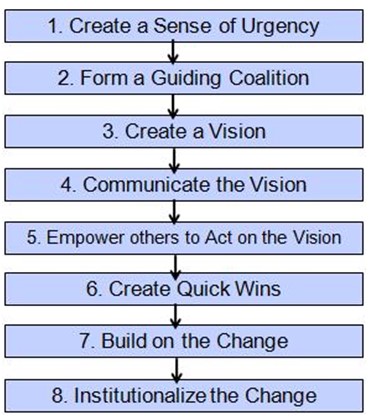
In the McKinsey 7-S Model below, “Staff” is indicated as one of the seven factors which affect organizational performance. If effective change was to occur in the organization, all the seven factors would need to be aligned meaning that Staff would need to be consulted and their opinions sought on the same (Peters 2011). Arguably, it is hard to apply the McKinsey 7-S model in the company.
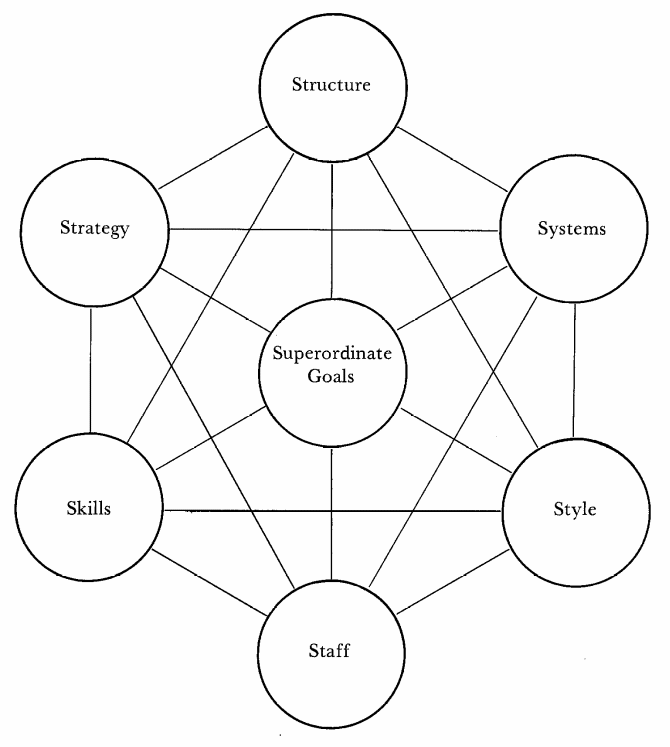
Management of change is in Kurt Lewin’s model (figure 3), is a process that involves unfreezing (identifying), internalizing and refreezing (integrating) changes (Sligo 2009). During unfreezing, individuals learn and practice new attitudes and values. During the internalizing phase, individuals absorb new skills, behaviors, attitudes and knowledge, something that enables genuine change to occur in and around them (Sligo 2009). Refreezing occurs as employees integrate the new knowledge, skills, and attitudes into their work routine.
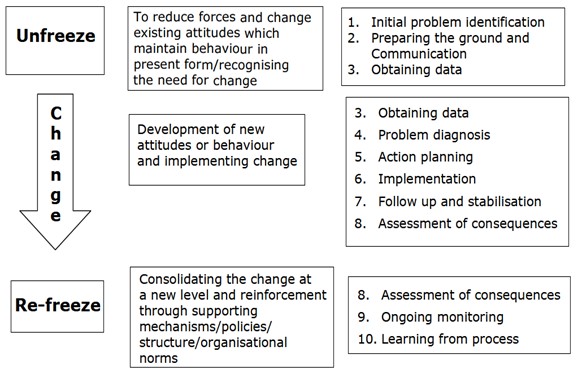
Research questions
- Was employee inclusion evident (or felt) during the change process in Omantel?
- Was employee decision making evident during the change process in Omantel?
- Did Omantel effectively manage change?
Significance of the study
This research will study the impact of employee inclusion (or lack thereof) in decision making during the change process in Omantel by taking note of decisions made by employees.
Project Design/Methodology
Epistemological assumptions
Researchers use two assumptions in their attempt to study knowledge. Positivist researchers try to study social realities using natural scientific methods. Interpretivist researchers on the other hand focus on understanding why humans act the way they do. In this research, a positivist approach will be taken since the researcher will be assessing the impact of employee engagement (or lack thereof) in Omantel’s change process.
Research strategy
Qualitative and quantitative approaches are the two prominent research strategies. Quantitative research is a study concerned with numerical data collection and analysis of the same. Quantitative research has the qualities of a controlled research (necessary to provide unambiguous responses), definition of terms (to avoid confusion), and replication (data should have the quality of replication). It uses deductive reasoning to explain social phenomenon. It also assumes positivism as a way of understanding occurrences in the society. Questionnaires are preferred as a means of quantitative research, and as such, a standard questionnaire will be developed and used as the main primary data collection tool for this research. The questionnaire will be developed to measure variables related to how well Omantel communicated changes that occurred during its privatization, how employees felt about their involvement (or lack thereof), and the consequences of Omantel’s engagement with the employee during the change period.
Sampling
The sampling criteria will include being a current employee with Omantel, who has been working with the company since January 2005. The questionnaire will be sent via email to 300 respondents who will be requested to fill in their answers and re-send to the researcher within one month. Email questionnaires are cost-effective and can easily be analyzed.
Ontological assumptions
Researchers make use of two ontological assumptions namely: objectivism and constructivism. Objectivism assumes that social realities can be identified through objective review, presumably because the realities exist outside the individual. Constructivism on the other hand assumes that people cognitively construe reality thus making it subjective. This study will adopt objectivism, since the research assumes that the reality regarding how Omantel handled its change can be established by investigating employee perceptions.
Sample research questions
The following will be questionnaire example questions.
- How did change affect you?
- Did you like the process?
- Is the change process beneficial to your knowledge?
- Were you consulted or involved in any decisions that were made during the change period?
- Are you better or worse after the change?
Conceptual Model
Conceptual modeling is important because it enables a person (in this case the researcher) to identify systematic relationships within different interactions in a model. As Wolff and Frank (2005, p.3) indicate, conceptual models are used to reconstruct “knowledge about the system”. This research uses the below illustrated conceptual model to indicate the effects of employees inclusion in change management.
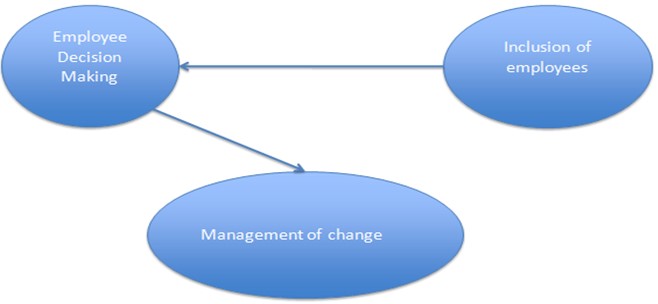
As indicated in the introductory part of this research, inclusion of employees involve engaging them emotionally and behaviorally in order to ensure that they have the passion, motivation and focus to undergo changes, and that they are willing to complete tasks in the change process. Employees’ decision-making in Omantel is unstructured, and as Tremmel (2007) notes, it is further challenged by ineffective business processes and unresponsive organizational structures. The foregoing notwithstanding, communication has been indicated as the main way through which managers can ensure the inclusion of employees in the change process. Communication during change should be indicative of five dimensions namely:
- Discrepancy: This involves informing employees the difference between a current and desired state of the firm. In other words, communicating discrepancies enables employees to understand why change is necessary (Jimmieson, Rafferty & Allen 2013).
- Appropriateness: this involves communicating why the proposed change presents the best strategic choice for the company. As Jimmieson et al. (2013, p. 198) note, “employees may perceive change as necessary but do not yet see the proposed changes to be appropriate”. Through communication, the managers can understand employees’ viewpoints, while expressing their own opinions, and justifying the appropriateness of the proposed changes.
- Personal valence: this is a dimension that caters for the personal concerns that employees have regarding the effect that changes have on their jobs (Jimmieson et al. 2013). Communication should be assuring, but honest to enable the employees handle the changes
- Principal support: this dimension refers to communication in which managers should assure and/or provide employees with support (e.g. through training) to enable them transit well during changes. It is indicated that at times, employees resist change because they feel inadequate. The resistance can wane if managers offer assurances and support to enable employees to transit to the desired outcomes effectively.
- Efficacy: this dimension contains statements that enhance employees’ confidence in overcoming challenges encountered during transitions (Jimmieson et al. 2013). In other words, employees need to be reassured.
As indicated in the conceptual model, only can inclusion can employee participate in decision-making. The foregoing is only possible through open communication. According Byrne et al. (2005) and Michaelis, Stegmaier and Sonntag (2009), open communication and disclosures lead to affective commitment to changes by employees, since they get support and encouragement from the management.
Following the above conceptual model, this research will establish if there was sufficient communication between the management of Omantel and its employees to guarantee their inclusion in the change process and management. In the end (i.e. after employee inclusion and involving them in decision making), effective management of change should be evident or lacking in the company.
Literature Review
When the need for organizational changes arises, managers need to focus on employees, since they (employees) are critical change agents (Wolff & Frank 2005).
Tremmel (2007) notes that as a telecoms company owned by the Omani Government, Omantel has a vertical structure. The foregoing means that decisions are made in a unidirectional, normally in a top-to-down approach. Notably, Omantel is awash with bureaucratic resistance, and the middle-level managers are especially resistant to suggestions or changes proposed by lower-ranking employees. Inclusion of employees involves engaging them emotionally and behaviorally in order to ensure that they have the passion, motivation and focus to undergo changes, and that they are willing to complete tasks in the change process (AON PLC 2013).
Despite the internal challenges Omantel has to deal with, Ram and Prabhakar (2011) note that the telecommunications sector in Oman is quite competitive. Omantel has therefore had to initiate several change management initiatives to increase its competitiveness. Change management requires managerial flexibility; if at all the company is to remain profitable despite stiff competition. As noted above however, the bureaucratic structure in Omantel often means that most of the resistance to change is seen in middle-level management. This research will focus on how Omantel managed change during the privatization process that occurred when the telecoms company had an initial public offering. Additionally, the research will readily evaluate these against different concepts and theories whose content defines such problems.
How Individuals behave during change
Feelings can be described as the sense of touch or understanding towards a particular thing (Paulsen et al. 2005). The feelings of employees during organizational change influence the success of the process. Managers must consider several factors that could influence or change the feelings of an employee towards an organizational change (Ram &Prabhakar 2011). The factors can be categorized into six dimensions.
- The feeling of loss of control or job routine by the employees
- The uncertainty surrounding the change process during organizational change
- Power change during management change
- Change in work schedules during organizational change
- Speculative or complete loss of authority by the employee during organizational change
- Misinformation and misunderstandings about the organizational change.
The six dimensions stated above influence employees’ feelings towards organizational change. The uncertainty during organizational change has been found to result in resistance among employees. When the employee has ill feelings about the organizational change, he or she will develop a negative attitude towards the organizational change. Although, managers execute the plan at different time, rumors of the change will circulate prior to the organizational change. For example, the employees can resist the news of the arrival of a team of analyst to verify a particular organization. Word of mouth will be used to convey the resistance message to the entire staff.
A number of scholars have conducted extensive studies to define an attitude, even though some definitions are common among researchers. In their research article Michailides and Lipsett (2012) note that an attitude entails a mental or neural state of readiness, which is often organized through an individual’s experience and skills. Based on their definition, it is clear that an attitude has an influence on an individual’s behavior, which exerts pressure on the decision-making mechanism as regards to the response to all sorts of objects, situations, and events that are related to it. The behavior in this case is influenced by an individual’s experience, temperament, and orientation to the world. An attitude is mainly related to the behavior of an individual, and is described as a complexity of things that psychologists refer to as personality. Other social scientists term it as ways of life, morals, behaviors, and incentives that guide and inspire an individual to perceive and respond to things in a specific way (Michailides & Lipsett 2012). In the workplace, debate on attitudes centers on the emotions and behaviors of employees, which are evident in their reactions to work situations. To understand the influence of attitudes on productivity of work, scholars of management have designed a model, popularly referred to as the tri-component model (Schiffman & Kanuk 2006). The tri-component model argues that attitudes can be explained through the cognitive component, the affective component, and the conative component as indicated in figure 5 below:
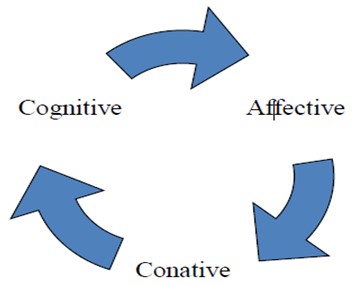
Theory and human change process
This Vroom Expectancy Theory suggests that employees earn motivation from what they expect in terms of rewards. The theory bases its argument on operant conditioning. Vroom expectancy theory posits that employees focus on rewards. If the reward is good, the employees put in effort to earn it. This effort leads to good performance. However, the employees want rewards in terms of intangible benefits. This includes special recognitions, learning, and development, involvement in making critical decisions, prompt and detailed feedback and most importantly listening from management.
According to this theory, if employees feel that when they perform well they will get the above-mentioned rewards, they feel motivated to perform. The theory uses terms such as expectancy, instrumentality, and valence. Valence is the attachment that an employee feels towards the reward. Therefore, management should create an environment that ensures employees get to specific rewards. These rewards should be valuable and have the ability to generate an emotional attachment in employees. For example, fully paid one-week holidays to exceptional destinations. However, this is only true if employees are already satisfied by basics such as remuneration, safety, and cleanliness. The study does not mention these aspects.
Operant conditioning is an old theory that seeks to know the needs of employees. It derives from classical conditioning. Although expectancy theory omits the fact that employees do not really want tangible things to look forward to, the study above explains this very well. The author says that employers should seek to know what employees look forward to from them. Additionally, the environment should be conducive to enable employees to state what they want. He says that this should be the employer’s initiative. This is because leaving this responsibility to employees is challenging. The study and the theory agree on this fact. This is because employees do not have power to structure their work in a different way.
Employee’s perception towards organizational change
The need for change is inevitable because organizations face external and/or internal pressures to change. Notably however, organizational change processes can be counterproductive especially if they are not well managed (Oreg 2006). If not properly communicated to, assured and/or motivated, employees are reluctant to leave his or her old job description for a new assignment (Paulsen et al. 2005). Sometimes, the resistance could be fear of losing his or her relevance in the organization (Oreg 2006). Some employees perceive a loss in position and/or entitlements should the change succeed (Martin, Jones & Callan 2005). Oreg (2006) however found out that employees who communicate with the executives easily accept change hence indicating the need for communication. Conversely, employees who are not effectively communicated to take longer to embrace change (Goodman & Truss 2004).
The level of influence in the decision-making process influences the employee’s perception of the organizational change (Goltz & Hietapelto 2002). When the management gathers employees’ opinions before the commencement of the change process, chances of resistance from the employees are minimal. Consequently, the level of education of the employee influences his or her perception towards the organizational change (Armstrong-Stassen 2005). The impact of employee’s inclusion in the decision-making of an organization influences the smooth transition during the change process.
The emotions of an employee towards change can be positive or negative depending on the level of responsibility attached to the employee (Oreg 2006). Employee’s profiles influence their feelings towards the organizational change (Piderit 2000, p. 56). The belief of a better job description may influence his or desire towards the change. Oreg (2006) suggests that management change could be achieved when the feelings, perceptions, and attitudes of the employees are captured in the processes of change. The feelings of employees towards change affect their performance, thus, employee’s inclusion in decision making during the management of change will provide a positive response (Oreg 2006)
Interventions in the change process
Including employees in the decision making process leading to organizational changes can be assessed by the success or failure of the organizational change. The consequence of an employee’s inclusion can be determined by the success of the organizational change (Beer & Nohria 2000). When the employees provide support to the change management, the change project will be successful. Employees’ inclusion will influence their perceptions towards the change process; their attitudes will influence the process of change in the organization. The staff strength will be utilized to improve and cushion the effects of the change (Lau 2001). Organizational change comes with its challenges; the process is not an easy one. The plan must be achievable, and the challenges can be reduced when the employees are included in the decision-making process (Beer & Nohria 2000).The consequences of employee’s inclusion in decision-making of change projects can be measured under the following categories. Each concept will measure the consequences of employee’s inclusion in an organizational change.
- Expectation levels: Employees inclusion in the decision-making process during change projects increases the level of expectation without resistance of the individual. Each employee will be prepared to provide efficient services without the feeling of burden.
- Commitment: The management may not require strict rules to enforce an organizational change. Each employee will be committed to his or her job description thereby, increasing the level of commitment to the organization.
- Level of communication: The level of cohesion between the staff and management will be strengthened when the employees are included in the decision-making process during change management (Grant 2011). The level of communication is directly proportional to the success of the organizational change.
- Positive attitude: Employees inclusion in the decision-making process during organizational change will create a positive attitude towards the organizational change. A positive attitude will improve the communication level in the organization.
A relationship at workplace is another organizational behavior, which presents itself in many cases, as well as the writings of many scholars. Judging from the context of various articles, old workers and newly introduced workers are not always in good terms. The old workers perceive the new workers as highly favored by the management and thus are doing what is in their capacity to frustrate their work life. This implies that the workers are in strained relationships with their managers (for the case old workers) and fellow workers (for the case of new works). In such situations, the relationships can strengthened if the management will consider forming a single group of workforce rather than the existing divisions that is composed of new workers on one hand and the old workers on the other hand.
Key to successful and sustainable change
A change process has to undergo a testing phase to ensure it is foolproof. During the test phase systems, the system used experimentally to ensure that the software has no faults, that is operating according to specifications and in the way users expect. Implementation is the process of checking and installing the latest equipment, train users, install the application, and build all the necessary data files for use. The evaluation of a system performed to identify strengths and weaknesses.
When making application for information system begins the first activity of systems the preliminary investigation. This activity has three parts namely clarification of application, feasibility studies, and approval of application. The key aspect of systems analysis is to understand all the important facets of the company that is under study. Analysts working with employees and managers should study the processes of a company to respond to the following key questions; what do you do? How come? What is the efficiency with which tasks performed?
Change is especially important for organizations that operate in competitive industries. A planned change is made with an intention of making the organization more efficient and effective. However, the organization faces a lot of resistance due to this change from the employees. The employees foresee potential threats and problems for them in the future, which is why they do not want the change to be implemented. Hence, the readiness for change from all the employees of the organization is vital component to implement the change successfully.
The Change Process
Assuming Omantel’s management decides to draw from Greiner’s six-phase change process, its change process would be as follows. Greiner identified the first stage as pressure and arousal. This meant that for the change process to begin, top management needed to be subjected to either internal or external pressure to change. In our case, the company’s management was facing external pressure from their competitors. The internal pressure came from the fact that they faced the task of explaining to the owners why the company was making losses. The second stage was intervention and re-orientation. This stage required management to work with an expert. The expert could be an outsider or a person working for the company. The catch was that, this expert had to report to the highest level of management. It was feared that management would simply ignore the problem if an expert were not involved. Omantel therefore required a marketing and sales expert.
The third stage called for recognition and diagnosis. It would involve the top management and the marketing and sales expert working with the low-level employees. They would carry out tasks in fact finding and problem solving. The importance of this stage would be to identify the various problems faced. In this case, the problems were reduced market share and the company was reporting losses. The fourth stage was invention and commitment. It would also require top management to work with both the expert and low-level managers. It would entail coming up with solutions to the problems identified. For this company the solution would be to cut on costs as it was making losses and its new strategies required a large financial outlay. It could do this by doing away with wasteful activities and taking away, some of the unnecessary benefits it provided for its employees. The importance of using the shared approach here was to avoid resistance later and simplify the implementation process.
The fifth stage was experimentation and search. Here the solutions made in the previous phase would be subjected to a series of test runs in some parts of the organization. The last stage would be reinforcement and acceptance, which would entail introducing the changes on a large-scale basis throughout the organization. This being the implementation stage, the company is bound to encounter some difficulties, which will be discussed below.
The Concept Model of Three
Inclusion of employees
Inclusion of employees can be defined as “the degree to which an employee perceives that he or she is an esteemed member of the work group through experiencing treatment that satisfies his or her needs for belongingness and uniqueness” (Short et al. 2011, p.1265). From the foregoing definition, it is clear that two factors affect employees’ inclusion: I) the perceptions that employees have regarding how they are treated in the work place; and II) the employees’ needs to be unique and belong to the organization. Notably, uniqueness refers to the exclusivity of talents, skills, or even culture. Even then, individual employees need to feel as part of the larger organization based on the appreciation of their unique traits by the management. Belongingness on the other hand refers to the idea of being treated as part of the organization (or as an insider). When a person’s sense of belongingness is not satisfied, he/she can suffer negative consequences at emotional, cognitive and physical levels (Baumeister, DeWall, Ciarocco & Twenge 2005). Specifically, employees are bound to feel rejected by either the management or co workers, and this is detrimental to their work attitudes as well as their psychological health.
In the figure 6 below, it is evident that inclusion is realized when high value is attached to employees’ uniqueness and there is a high sense of belongingness among employees.
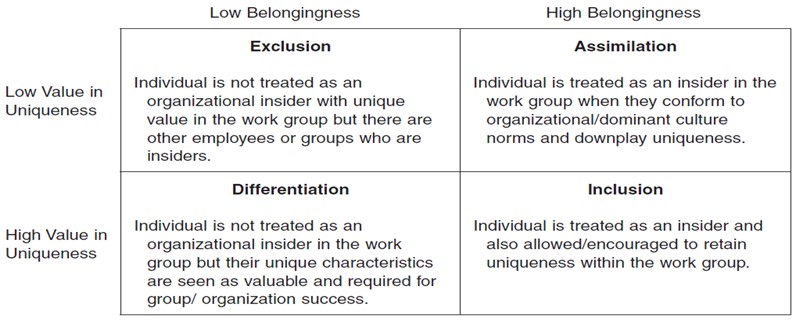
The relevance of employee inclusion during change management is that when they are treated as insiders, details about the intended change are communicated to them in good time (Allen, Jimmieson, Bordia & Irmer 2007). Additionally, they are not required to drop their uniqueness; rather, the change management process is conducted in a manner that ensures that uniqueness is valued (Allen et al. 2007). Applied in context for example, the proposed research would find out if employees were briefed in good time regarding the privatization of Omantel. Moreover, the researcher would be interested in identifying whether the new ownership structure enhanced uniqueness among employees in the company or whether the value placed on employees’ uniqueness was worse off.
Employee decision making
Decision making, is by nature, a “motivated, cognitive process” (Wood & Bandura 2009). In other words, for employees to participate in decision making, they need be cognitively aware of their role in the same, and must also be motivated to participate. Notably, for decision making to produce socially mediated and distal outcomes, there needs to be multiple information sources. The foregoing means that although the management may be the predominant source of information for employees, there are also other sources, such as the media, analysts, and critics, who combined, provide employees with information needed for decision making. It is worth noting that not all information that employees are exposed to is factual; as such, it is the management’s responsibility to ensure that employees are motivated and guided through the provision of verified factual information (Wood & Bandura 2009).
The communication done by the management is a key source of information, and based on the same, employees construe perceptions regarding their positions in an organization in the future (Wood & Bandura 2009). For example, employees may construe the need to increase their skills if the communication passed to them by the management indicates the need for more knowledge and competencies. If the communication puts employees’ abilities into question, Wood and Bandura (2009, p. 410) argue that such “heightens evaluative concerns about personal competence” and such concerns can have different effects in employees’ cognitive functioning. The foregoing happens because employees perceive their abilities as a fixed factor. Employees’ cognitive functioning affects their decision making during change and can also be explained through social cognitive theory. According to Wood and Bandura (2009, p. 410), social cognitive theory indicates that “affective self-evaluation, perceived self-efficacy for goal attainment, and personal goal setting” are the self-regulatory mechanisms that affects how people gauge themselves against real or perceived expectations. In other words, communication by the management helps employees decide whether they measure up to the requirements of the future organization that will have undergone change.
Overall, employee decision making is vital in change management because the right decisions can only be made if the right information is provided by the management to employees. The foregoing puts emphasis on the need to establish effective communication strategies before and during change, in order to ensure that employees are not misinformed. In the case of Omantel, it would be interesting to find out if employees understood what privatization was about, its effect on them, and how the management engaged them during the entire process.
Management of change
Management of change refers to four distinct areas which include: the task of change management; professional practice involving change management; knowledge about change management; and the control mechanism of change (Nickols 2010). The focus for this paper will be on “the task of change management” as indicated by Nickols (2010, p.3). By perceiving management of change as a task, this paper admits that the “changes to be managed lie within and are controlled by the organization” (Nickols 2010, p. 2). Additionally, when perceived as a task, management of change has a meaning that suggests that people in an organization are responsible for planning, making and managing the changes in a systematic manner. As Nickols (2010) observes, some of the changes that an organization has to manage are triggered in the external environment. In the case of Omantel for example, the pressure to privatize might have come from market forces that made government ownership less desirable in a market where competition would open up the telecommunications sector. When the external environment calls for change, the organization has to respond even though it might have little or no control over the changes taking place (Nickols 2010). Whichever the case (i.e. whether the changes are anticipative and proactive in response to internally instigated changes or reactive in response to external pressure), an organization needs to manage the impact that change has on people. The management has to help people (employees) cope with any challenges, uncertainty, and/or fears that arise during the change process. In the Omantel case for example, the proposed research will seek to find whether the management in the company then, helped employees come to terms with the challenges, uncertainties and/or fears that arose during the change process. Management of change can also be seen as a process, especially if Kurt Lewin’s model (explained elsewhere in this paper) is adopted. Following Lewin’s model creates the impression that change is staged for purposes of upholding stability in the organization. Overall, change managers need to realize that it’s the uncertainty that comes with change that most people (employees especially) are most afraid of. Assuring the employees, motivating them, and informing them through effective communication thus need to be at the core of effective management of change.
References
Allen, J., Jimmieson, N.L., Bordia, P & Irmer, B. E 2007, ‘Uncertainty during organizational change: managing perceptions through communication,’ Journal of Change Management, vol. 7, no.2, pp. 187-210.
AON PLC 2013, ‘Managing employee engagement during times of change’, AON Hewitt, pp. 1-11.
Armstrong-Stassen, M 2005, “Coping with downsizing: a comparison of executive-level and middle managers”, International Journal of Stress Management, Vol. 12, no. 2, pp 117-141.
Baumeister, R., DeWall, C., Ciarocco, N & Twenge, J 2005, ‘Social exclusion impairs self-regulation,’ Journal of Personality and Social Psychology, vol. 88, pp. 589-604.
Beer, M & Nohria, N (Eds) 2000, Breaking the code of change, Harvard Business School, Harvard.
Byrne, Z., Kacmar, C., Stoner, J & Hochwarter, A 2005, ‘The relationship between perceptions of politics and depressed mood at work: unique moderators across three levels,’ Journal of Occupational Health Psychology, vol.10, no.4, pp. 330-343.
Goltz, M & Hietapelto, A 2002, ‘Using the operant and strategic contingencies models of power to understand resistance to change,’ Journal of Organizational Behavior Management, Vol. 22, no. 3, pp 3-22.
Goodman, J & Truss, C 2004, ‘The medium and the message: communicating effectively during a major change initiative,’ Journal of Change Management, Vol. 4, no. 3, pp 217-228.
Grant, R 2011, Contemporary strategic management: An Australasian perspective, John Wiley and Sons Australia, Milton.
Jimmieson, N., Rafferty, A.E & Allen, J. E 2013, ‘Quality change communication and employee response to change: an investigation of the moderating effects of individual differences in an experimental setting,’ In S Oreg, A Michel & R Todnem (Eds.), The psychology of organizational change: viewing change from the employee’s perspective, Cambridge, Cambridge University Press, pp. 198-250.
Kathiwalla, I 2012, ‘Omani telecommunication sector,’ Oman Arab Bank, pp, 1-11.
Lau, R 2001, ‘Competitive factors and their relative importance in the US electronics and computer industries,’ International Journal of Operations & Production Management, vol. 22, no. 1, pp 125–135
Martin, A, Jones, E, & Callan, J 2005, ‘The role of psychological climate in facilitating employee adjustment during organizational change,’ European Journal of Work and Organizational Psychology, vol. 14, no. 3, pp 263-289.
Mathew, S 2013, ‘Omani government plans to sell $574 million stake in Omantel,’ Business Week. Web.
Metre, C 2009, ‘Deriving value from change management,’ Journal of Science in Organizational Dynamics, vol. 1, no.1, pp. 1-47.
Michaelis, B., Stegmaier, R & Sonntag, K 2009, ‘Affective commitment to change and innovation implementation behavior: the role of charismatic leadership and employees’ trust in top management,’ Journal of Change Management, vol.9, no.4, pp. 399-417.
Michailides, T & Lipsett, M 2012, ‘Surveying employee attitudes on corporate social responsibility at the frontline level of energy transportation company,’ Corporate Social Responsibility and Environmental Management, vol. 20, no.5, pp. 296-320.
Nickols, F 2010, ‘Change management 101 – a primer,’ Distance Consulting LLC, pp. 1-11.
Oreg, S 2006, ‘Personality, context, and resistance to organizational change,’ European Journal of Work and Organizational Psychology, Vol. 15, no. 1, pp 73-101.
Paulsen, N, Callan, J, Grice, T, Rooney, D, Gallois, C, Jones, E, Bordia, P. &
Peters, T 2011, ‘A brief history of the 7-S (“McKinsey 7-S”) Model.’
Piderit, K 2000, ‘Rethinking resistance and recognizing ambivalence: a multidimensional view of attitudes toward an organizational change,’ Academy of Management Review, Vol. 25, no. 4, pp 783-794.
Ram, P &Prabhakar, G 2011, ‘Privatizing monopolies in the telecom sector- lessons from the employee job satisfaction perspective,’ International Journal of Humanities and Social Science, vol. 1, no.6, pp.79-88.
Schiffman, L.G & Kanuk, L.L 2006, Consumer behavior, 8th edition, prentice Hall, London.
Shore, L., Randel, A., Chung, B., Dean, M., Ehrhart, K., Ehrhart, K. H & Singh, G 2011, ‘Inclusion and diversity in work groups: a review and model for future research,’ Journal of Management, vol. 37, no.4, pp. 1262-1289.
Sligo, F 2009, ‘Managing change- introduction.’
Tremmel, L. R 2007, ‘Workforce diversity in the Middle East.’
Wolff, F & Frank, U 2005, ‘A multi-perspective framework for evaluating conceptual models in organizational change,’ pp.1-12. Web.
Wood, R & Bandura, A 2009, ‘Impact of conceptions of ability on self-regulatory mechanisms and complex decision making,’ Journal of Personality and Social Psychology, vol. 56, no.3, pp. 407-415.